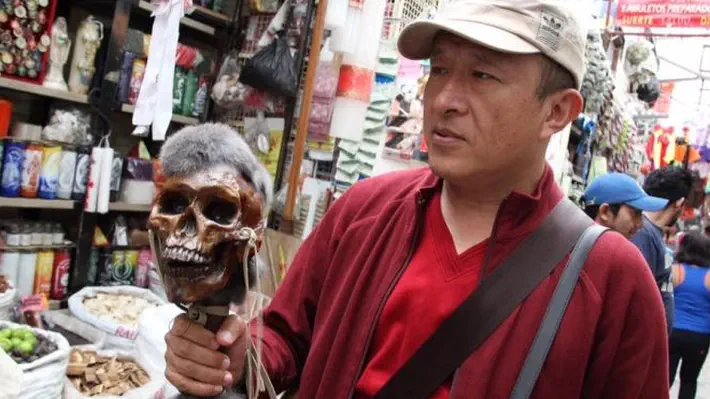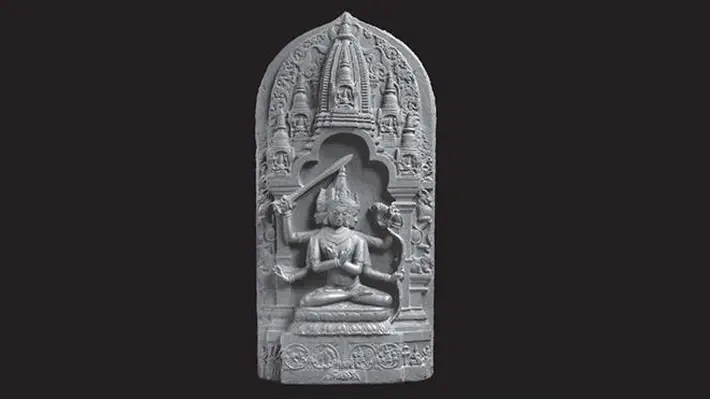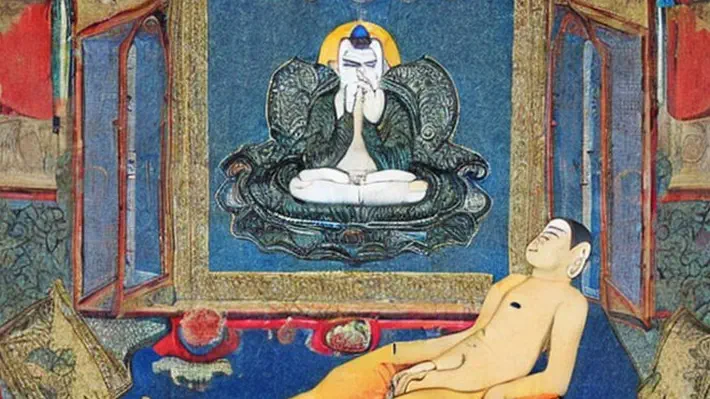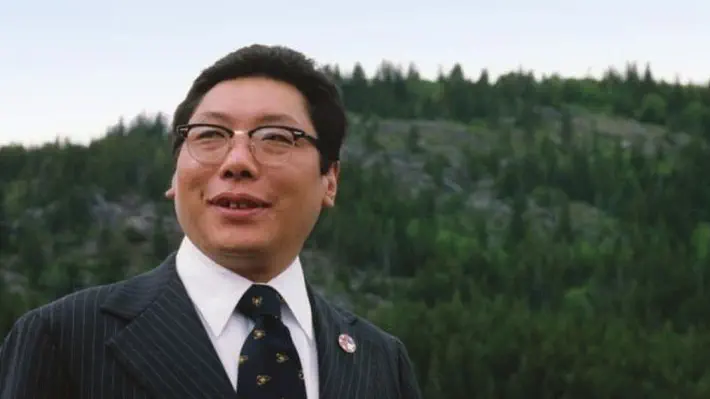Dharma: The Guru Drinks Bourbon?

A book by Dzongsar Jamyang Khyentse Rinpoche, buy at amazon.com or amazon.com.br
Deciding to follow another human being—not a god, not a machine, not nature, not a system of governance, not the sun or the moon, but a shower-taking, sleeping, yawning, shitting, moody, bribable being—is either the most stupid thing a person can do, or the most rewarding. It is a gift to have this inclination and the tenacity to follow it. It is a gift to have doubtless confidence. It is a gift to be able to kill doubt with doubt. Not everyone has these gifts.
In the result path, because all phenomena are equally pure and perfect, there is no difference between a disciple and a guru—they are equally Buddha. A nihilist academic from Oxford University, an eternalist priest from the Vatican, and a yogi from the Himalayas are equally Buddha. There is not one ounce of difference among them. A disciple equipped with the proper faculties and conditions can even extract blessings from Richard Gombrich or Stephen Batchelor.
At a time when the Beatles had ponytails and it was all the fashion to wear bell-bottoms, smoke marijuana, wash with vegetable soap, and keep long fingernails, there was a rebellious freedom in the air, a trend of going slightly against the system. There was also a trend of spiritual seeking. Chögyam Trungpa Rinpoche came along and insisted that all the Vietnam War–protesting Dharma students wear khaki uniforms, ties, and suits with pins. He even made them march like British soldiers on American soil. He combined Japanese simplicity and elegance with colonial British style and imposed all of this on the Woodstock-going hippies. It sounds crazy, but each command was so skillful. These were Trungpa Rinpoche’s pith instructions.
If a Zen master asks, “What is the sound of one hand clapping?” at the right time to the right person, such a seemingly ridiculous question can be a profound and valuable pith instruction. Likewise, methods such as ngöndro (the classic Vajrayana preliminary practice), visualizing yourself as the deity, controlling the breath, the infinite and elaborate construction of mandalas, burning food, wearing amulets, using emotion as the path, and not treating emotion as a nemesis can all be pithy and profound. The Vajrayana’s mantra recitation is as absurd as the sound of one hand clapping, as pointless as concentrating on the philtrum just below the nostrils. Yet mantra can be a powerful nutcracker that cracks the shell of conventional thinking.
How each individual enters the path of the Dharma is so personal. There was once a young gangster named Tsangyang Gyatso (not to be confused with the Sixth Dalai Lama) who stole a team of horses from a traveler. Because he was the youngest of the gang, it was his job to herd the horses up a steep hill. One of the horses was pregnant and couldn’t walk. Tsangyang Gyatso became so infuriated that he slashed her stomach with his knife and the foal came gushing out. As the mother was dying, she kept taking care of the foal with her last bit of energy, cleaning it and nuzzling it. Her expression of motherhood triggered so much regret in the gangster, so much feeling, that he broke his knife, tossed his gun, and became a disciple of the great Nangchen Tsöknyi Rinpoche.
Nangchen Tsöknyi himself belonged to a wealthy family in Tibet, but somewhere along the way the family had picked up a bad habit of gambling and lost everything. In desperation, they started engaging in petty theft and robbery. Eventually they were caught, and the whole family, including Nangchen Tsöknyi, was put in Nangchen prison, where they starved. His family’s complete decline from the wealthiest clan to a bunch of petty thieves gave him a deep understanding of the impermanence of life. While imprisoned, he witnessed and experienced intense suffering, which led him onto the path of becoming a great practitioner and then a great master.'
MIRIAM’S DILEMMA
Miriam was an intellectual, intelligent English woman born to a Persian family. I met her when I was studying at the School of Oriental and African Studies (SOAS) at the University of London. She also studied comparative religion at SOAS, and was a lecturer on Buddhism and Hinduism at the University of Bath. She was very well versed in Asian philosophy, especially ancient Indian logic, and she thoroughly understood the Madhyamakavatara. She could sometimes explain concepts such as emptiness and dependent arising better than trained religious teachers because she didn’t have a biased attitude. When she explained, she did so methodically, scientifically.
Miriam came to see me many times, even though I had nothing to teach her. She had no philosophical questions to ask because she knew the answers better than I did in some cases. Nevertheless, she would often come to our Buddhist practice gatherings at my small flat on Notting Hill Gate. About ten people would show up, mostly staunch Buddhists, to do feast offerings and chant. My friend Yvonne was often there and, much to my embarrassment, would uncontrollably blurt out her devotion with hiccups and twitches in the presence of Miriam. I couldn’t help but wonder what such an intellectual was thinking of these groupies carrying my shoes and treating me like a supreme being.
One day Miriam made a point to be the last to leave so we could be alone. She was obviously in a mood, so I asked her what was wrong. Tears sprung from her eyes as she told me that she wanted to have devotion but could not. She might have felt some affinity for me because we were both committed to the same philosophical exploration, but that affinity stopped short of devotion to me as a guru figure. By nature she was very critical of spiritual gurus and especially wary of anything resembling a cult figure. So even though her conviction to the philosophy was strong, devotion was not arising. What’s interesting is that even some of Miriam’s own students in Bath ended up developing devotion through her lectures, yet she never did.
I could not advise her except to say that devotion is not something you can develop through learning alone. But for her to shed tears because she lacks devotion is something to pay attention to. Aspiration alone is very powerful. Her feeling of something lacking might eventually lead her to a more vigorous search. Although I don’t know where she is now, I sometimes hope that she has not stopped shedding those tears.'
Mr. Tyler, whom I taught when I was invited as a guest lecturer to Oxford University, was very academically minded. But for years after my visit, he kept seeking me out, wanting to hang around me, at times to my annoyance. He wanted to be there when I was watching football, when I was going for a walk in an English garden, when I was eating out. And he sometimes would ask for a private audience, which always ended up with him saying completely useless things. He would behave so uncomfortably that I refused to give him an audience anymore. Then one day Mr. Tyler said he had one last request. He was sweating. He became nervous. Finally I got the point: he wanted me to be his teacher. I can see why he had been so awkward. For years he had presented himself as an academic, and switching was difficult for him.
In places like Oxford University, to admit devotion while being academic is like admitting you are gay in a homophobic environment. How likely are you to come out of the closet? As much as academics want to think they are liberal and open-minded, their tyranny of objectivity is ruthless.
Some people consider Chögyam Trungpa Rinpoche to be the most notorious perpetrator of spiritual abuse in history, a man who died because of alcohol and indulgence. It’s understandable to think this way because of how he chose to manifest. Generally there is this notion that spirituality and vices like sex, alcohol, power, and money go together like oil and water. But it seems Trungpa Rinpoche was able to use vice as a skillful means.
Sometimes you can tell the greatness of a teacher through the greatness of the students. After meeting many of Trungpa Rinpoche’s students over the years—witnessing their seriousness, their veneration to the Buddhadharma, their dedication to the guru—I cannot dismiss them as crazy and ignorant; I cannot say they are a disgrace to the Buddhadharma.
Just as some people are inspired by the Dalai Lama’s humility, laughter, and nonviolence, many of Trungpa Rinpoche’s students were attracted to him because of his outrageousness. He came to America in the early 1970s and worked with a very rebellious group of hippies, spiritual seekers, and Vietnam War protesters. They were the least likely type to bow down to a khaki uniform, and yet Trungpa Rinpoche was able to work with them in this way. More than six hundred families left their homes and jobs and moved from all parts of America to some gloomy place called Halifax. They created schools to teach wisdom and compassion. Their children grew up thinking twice before squishing a mosquito. Some of his students even became monks and nuns—exemplary ones, like Ani Pema Chödrön. And even long after he passed away, they continue having genuine interest in dependent arising. They value nonviolence and promote contemplation, and they dedicate a big chunk of their lives to meditation and retreats. And this community is not like the segregated Amish; rather, they are very much blended into society. Their symbolic warrior, discipline, is directly and indirectly associated with dignity, courage, and enlightened society, qualities that that part of the world gravely needed.
Are there any serene, gentle monastics from Chögyam Trungpa’s generation who have accomplished this much in the West? I’m still looking.
A Vajrayana master will impose Tibetan culture on an Israeli student, even though that culture means nothing to the Israeli. Of course, if an enlightened master enforces Tibetan dress, Tibetan food, and Tibetan ways of thinking, and this really crushes the Israeli ego and habits, it can be taken as an enlightened method. But ultimately, if the Dharma is to be established outside Tibet, culture and habits must communicate. Culture is not what is being transferred; it’s not the point. If you are Israeli, no matter how fully devoted to your Tibetan master you are, the chance of you becoming a Tibetan in this life is zero, whereas tapping into your buddha nature and applying appropriate methods for waking yourself up from delusion and reaching enlightenment are very possible.
There is no right and wrong here. You cannot say outright that cultural trappings don’t work at all. For centuries, the Tibetans had never seen a lotus flower. There are no lotuses in Tibet; the idea was imported from Indian culture. The only thing they knew was that the lotus grows in mud, yet they painted lotuses and visualized lotuses. They were and are such a big symbol. The same is true of the wish-fulfilling cow. There were no cows in Tibet in those days. Cultural images and icons have their purpose. They are definitely not the Dharma, but they can serve to communicate it."
'When Rechungpa asked Milarepa, “Whose manifestation are you?” Milarepa said, “I don’t know. I could be a manifestation of all three lower realms put together, but if you think I’m Vajradhara, you will receive the blessing as if I am Vajradhara.” Keep this advice in your hearts.'
When Guru Rinpoche came to Tibet, he refused to mention the name of his guru. There are many accounts of this kind of discretion. Especially as a tantric Buddhist, one tries not to mention the guru’s name, let alone flaunt that he or she is one’s teacher. The guru, deity, and consort are the three things meant to be kept totally confidential because they are the most sacred. Ideally, one should even keep the fact that one is a tantric practitioner secret. But we always end up corrupting these methods. In fact, nowadays most people carelessly flaunt their gurus, even me.
In Bhutan the practice of veneration has almost been reduced to a form of etiquette. The Bhutanese feel obligated to bow and receive blessings, so they end up bowing to just about any being whose name even remotely resembles a rinpoche or lama. Usually the lama will place his hand on their heads at ceremonies or at significant partings or greetings, but now it’s become excessive. They receive blessings every morning, every evening, every time they have been apart for a while.
In contrast, once I was in Lhasa circumambulating the Barkhor and this tall Khampa followed me a few times around. Like many Khampas, he openly stared at me, without inhibition. Finally, I grew tired and sat on a bench, so he approached me. “I heard you are Dzongsar Khyentse,” he said, and I replied, “Yes, I think so, that’s what people call me, anyway.” He then undid his long Khampa braids that were wrapped around his head and said, “In that case, can you put your hand on my head?” But he didn’t bend down, and I had to exert quite a lot of effort to reach the top of his head. Then he wrapped his braids back around his head and took out his wallet. He kept maybe ten renminbi, and the rest he crumpled up and shoved in my bag without any envelope or formality. He said something in Tibetan akin to “Don’t mess up”—indicating that he had surrendered to me, and I should take care of him. I met him many times after that, and never again did he ask for a blessing. For him, a onetime hand-on–the-head was enough to do the job. He didn’t feel obligated to be blessed again and again.
Again, enlightenment is the main purpose of having a guru-student relationship; therefore, it’s a waste of time to ask petty questions and seek confirmation of all your values and judgments. The constant need for evidence that you have been properly heard by the guru can become an obstacle. Jamgön Kongtrul Lodrö Tayé, quoting Jamyang Khyentse Wangpo, said that the two most important events of our lives—birth and death—can’t be negotiated and debated, so what’s the point of deliberating about all the other petty things in between? It’s totally useless.
When I was growing up, the number of tulkus per student was much lower than it is today because people dared not recognize tulkus. All the eyes watching and ears listening were so well informed. So people behaved. They didn’t start scanning their Rolodexes for relatives who might fit the bill. It’s like if you were to teach Shakespeare to a group of Oxford students: because these people have been brought up with the bard and can recite his verse by heart, you would make more of an effort to teach it correctly. There was a natural self-regulation and communal screening process in ancient Tibet and Bhutan that’s now waning. Individualism is on the rise.
There is another factor that is impacting the selection of heirs. So many new Buddhist practitioners and people interested in becoming Buddhist are emerging from both China and the West. Because there are so many of these new students, they have weight; the sheer numbers give them sway. But they are new, and many lack a certain discernment. So while they are not that informed, they are eager followers, and with their relative wealth they become big donors and sponsors. They are attracted to the idea of big names and lineages and tend to champion what is obvious and in their faces. Their money speaks: they endorse recklessly, and the lamas, the lamas’ families, and the institutions take advantage of this. It is having a big impact on the tulku system.
Another problem with the selection of heirs is that more and more, their value is determined by their administrative skills—their ability to run institutions and monasteries—rather than their qualifications as inheritors of the spiritual lineage. The whole purpose of the institution of the guru is to promote the spiritual path. When Shakyamuni Buddha appointed Kashyapa as his regent, he was not looking for someone who was skilled at management; he was looking for a great master to continue the lineage. Today, because heirs are selected for their skill as administrators, great administrators are taking over.
But having an administrator might be better than having the whole mandala of the guru hijacked by the guru’s overenthusiastic relatives, cousins, brothers, sisters, and wives.
"YOUR MIND WILL BECOME tamed by the very act of searching, finding, and associating with the guru. In the beginning you may not be able to make full use of the guru—you may not be able to see the guru as a mirror, or you may not be able to gaze into that mirror and see the reflection of the nature of your mind as pure and perfect—but you can begin capitalizing on the presence of the guru right from the beginning. The agony of searching and the fear of not finding, the second thoughts, the feelings of vulnerability and defenselessness, being on the verge of chickening out, and finally jumping headfirst and riding the ups and downs of the nuances and paraphernalia of guru devotion . . . enduring all of that is the most sophisticated form of mind training. One day of searching for a guru could equal more mind training than nine days of vipassana, because here you are not sitting on a secure and comfortable cushion with everything scheduled."
'The reason it takes a long time to actualize enlightenment is because of the strong, illusory habit of ego clinging. In the Vajrayana, you consciously look for a person who will destroy this habit. It’s not the same as Atisha Dipamkara bringing along an annoying Indian travel companion so that he could practice patience. We are talking about something far more extreme than that. We are talking about peeling off the skin of all your ego-related habits, showing no mercy to the ego, systematically destroying the ego at all costs, in every way, as quickly as possible. If the whole process of finding and associating with the guru does not destroy the lifeline or extinguish the breath of the ego, it should at the very least tame your mind.
“Of all pith instructions from the guru, the one that hits your fault is the most precious.”—Longchenpa'
"Some people say you practice to achieve the same rank as the guru. No. You aren’t promoted to a certain state. You have to become inseparable."
"One of the savviest methods for taming our minds on the path of guru devotion is generating gratitude. Gratitude is essential even in Mahayana Buddhism. According to the Mahayana, you should treat whoever introduces you to the sutra of Prajnaparamita like the Buddha because the truth of nonduality is so priceless. Just think how much we should venerate the person who introduced us to the innate wisdom of the Tantrayana, circumventing logic and analogies to directly point out our innate wisdom.
In order to make a living as a carpenter or a stockbroker, you must receive training, and if your teacher is kind enough to give you treasured trade secrets and instructions on how to succeed, you will certainly be grateful. If this kind of gratitude comes naturally when we go about our worldly endeavors, it should go without mentioning that we are naturally beholden to our gurus, who give us the pith instructions on how to undo the net of delusion.
Thousands of buddhas have come and will come, but we individuals have no direct communication with them. Due to the power of our merit, or lack thereof, when the Buddha was walking on this earth, we were not there, and we can’t be sure if we will be present when the future Buddhas come. Even if the Buddha were to come stand before us today, how sure are we that we would be able to communicate? In the sutras we are told that buddhas and bodhisattvas are manifesting everywhere. We must be encountering them in one way or another, but due to our karma, we are not able to see them as buddhas and bodhisattvas.
In contrast, the present-day guru is here during our time, functioning, speaking, relating, and interacting with us. Through an inexplicable karmic connection, we have veneration, toward this person. In myriad ways the guru is trying to wake us up, explaining what is virtuous and what is nonvirtuous, what is absolute and what is relative, what is the true nature of our minds. And to the extent we are able to see him as such, the guru in front of us is the Buddha. If the mirror is only partially clean, only a partial reflection will come. But that’s already quite good, and we can be grateful."
"What makes the Buddhist path so special is that it looks dualistic, but it has that ability to liberate you from the bondage of dualism. It is a deliberate and conscious knot that is consciously and deliberately designed to undo itself. All the skillful means and methods of the Buddhadharma are like a thorn that we use to take out another thorn in our hand. The purpose of renunciation mind, compassion, the recitation of mantras, and contemplation on the breath is to dig out dualism. These practices will dismantle the puzzle of dualism. They speak the language of the nondual and have the flavor of the nondual. For example, compassion is definitely dualistic, but with heavy investment, it leads you to nonduality."
"Imagine a beautiful casket so finely crafted that once it is shut, the seam between the lid and the base is entirely invisible. It appears to be a single, exquisitely worked piece of wood, not a casket at all, and nothing about it suggests any possible opening. This casket is exactly like samsaric life. Day after day, year after year, lifetime after lifetime, samsara has been so intricately contrived by the ego, the master craftsman, that the notion it can be broken open never suggests itself. If we stopped for a moment and took a long, hard look at our version of the world, we might detect a few tiny cracks here and there, but for the most part the thought doesn’t enter our heads.
If, by some chance, a tiny crack were to be discovered and someone managed to open the casket just a little, the entire system that is samsara would be disrupted. Nothing would ever be the same again, and the one who achieved this monumental feat would have shuffled one step closer to enlightenment. Of course, you would still be stuck with a partially open casket, but its workings would no longer seem so utterly mysterious.
A multitude of inexpressible things can open the casket anytime, anywhere, triggered by the most ridiculous situations—if you have merit, devotion, and pure perception. This opening is usually initiated by the guru—by a remark, a gesture, or perhaps a note."
"Tashi Namgyal was the son of a Derge aristocrat who was offered as an attendant to Jamyang Khyentse Chökyi Lodrö when he was very young. Later he became my first attendant. He told me the story of how he and Khyentse Chökyi Lodrö traveled to Sikkim together in the late 1950s. Around that time, many Tibetan lamas were escaping the Cultural Revolution. Every day Khyentse Chökyi Lodrö would ask Tashi Namgyal who else had arrived from Tibet. When he heard that his close friend Dilgo Khyentse Rinpoche, who was both his student and his teacher, had managed to escape, he expressed great relief and said, “The Dharma will be safe now.”
Tashi Namgyal said that just before Khyentse Chökyi Lodrö passed into parinirvana, he met with Dilgo Khyentse Rinpoche in Sikkim and had a long conversation, and shortly after that, Khyentse Chökyi Lödrö died. Tashi Namgyal said there was an immediate and very obvious change in Dilgo Khyentse Rinpoche. He said that when Khyentse Chökyi Ldrö was alive and teaching, Dilgo Khyentse Rinpoche was nowhere near as eloquent or majestic as he suddenly became and as we all came to know him to be. The older students could visibly see a complete transformation.
Kyabje Dilgo Khyentse Rinpoche received not just Khyentse Chökyi Lodrö’s knowledge; everything was transferred—his aura, his way of thinking. This is the ability of a great master, and the recipient might not even consciously know it has happened."
"As a Buddhist, especially in the Vajrayana, it’s not your aim to fit into society. Almost the opposite. You don’t want to fit into society. You want to be an outcast."
"Tantric practitioners are not really worshipping a guru because of his personality, his achievements, his charisma, or his reputation. It’s nothing personal at all. A tantric practitioner has to see everyone as the guru. Not only that, a tantric practitioner has to see everything as the guru’s form, every sound as the guru’s voice, and every thought as the guru’s mind.
So eventually all your idealizing, sycophanting, and ass kissing of a guru will mature so that you will do that to everyone, even those who irritate you the most, and everything that enters your consciousness. When that starts to happen, you are beginning to subdue and outshine appearance and existence instead of existence and appearance subduing and outshining you, which is probably what is happening in your experience of phenomena now."
"WARNING
If you cherish the Dharma, if you are a karma-fearing, consequence-fearing believer of cause, condition, and effect, and if you believe in karmic debt, then guru is the last job I would recommend for you. If you don’t have the pure motivation of helping others, if you have a steel heart that allows you to disregard all the things listed above, then maybe being a charlatan might be a lucrative temporary position. If you are not a very successful charlatan, probably both you and your students will not suffer much. But if you are even slightly successful in convincing others to follow you, due to their karmic debt to you, be warned: you, as a guru or teacher, cannot imagine the power and wrath generated by the expectations and assumptions of masses of students.
Trying not to ignore people, living in constant paranoia of making the mistake of ignoring people, being anxious about forgetting someone on your party list, worrying if someone will get hurt, worrying about your reputation, agonizing over the possibility of losing your students to a better teacher, trying to look austere like an ascetic while your habit of looking like a fat, rich gangster keeps kicking in, and worst of all, never enjoying a moment of privacy because thousands of eyes are always on you, watching what you are doing and who you are doing it with. . . . On top of that, all the emotional blackmail coming from all ten directions because the disciples came with supposedly goodwill and devotion will stress you out."
"Accountable Only to Karma
Many world religions have a hierarchical structure with a top tier that receives reports from a network of local representatives. If there is a report of misbehavior, the higher-ups are empowered to decide the fate of the wrongdoer—for example, a priest molesting children.
Some monasteries have their own kind of hierarchy: there is a rinpoche, an abbot, khenpos, lamas and lopons, and then the regular monks. Whatever system may exist at a monastery is a completely human invention specific to that location; it’s not the Dharma. Nowhere in the teachings will you find a Buddhist system of management, let alone instructions on setting up a congregation or hierarchy, democratically elected or otherwise. Certainly, there are rules and guidelines regarding the sangha, and in particular how to treat elders in the sangha, but there are no instructions on politics, administrative systems, or the organization of monasteries.
If there is a complaint within a sangha, there is no Buddhist process to penalize the guru. There is no system to say, “This guru is banned from teaching.” The Vajrayana is totally individual. There is no caliph, no sharia law, no party leader who decides who should be punished and who should be rewarded. If there is any system, it is the law of cause and effect. The guru, if he is not an enlightened being, is subject to karma, and therefore his deeds will contain their own punishment or reward.
Having no system is not a weakness. Systems are corruptible, just as anything run by human beings is corruptible. When a religion becomes a dominating power, politically or financially, there is potential for people to be mistreated. If there is no system, there is nothing to corrupt. There are many examples of Buddhists trying to create rules and structures, and in general, these efforts have had a bad effect on individual practice, as we have seen in Tibet."
"One important distinction is that being a therapist is a profession, but being a guru is not and should never be. It’s not a way to 'make a living,' so to speak. One should live for the Dharma, not use the Dharma for a living. This is one of the most degenerate and dangerous things that can happen."
"Transparency
It’s human nature to express appreciation and gratitude by bestowing material offerings and offerings of one’s time and energy. While generosity and detachment and surrender are of course very important practices for the student, any guru who accepts offerings has to be extremely careful.
One of the foundations of Buddhism is the Noble Eightfold Path: right view, right intention, right speech, right action, right livelihood, right effort, right concentration, and right understanding. Right livelihood is explained as making a living in a way that does not harm others—not cheating and not deceiving, directly or indirectly. In the Vinaya, the Buddha explains in meticulous detail what might constitute deception. For example, a monk waiting in line for food should not hide his vegetables under his portion of rice to make the server feel he hasn’t been served.
Many great practitioners of the past prayed to never become famous, powerful, influential seat holders because of the inherent dangers involved. The most dangerous of all is the receiving of so many privileges and gifts—the best seats, first choice at the buffet. For an aspiring guru, making miscalculations or taking advantage of this position is much worse than killing or stealing or sexual misconduct. As I mentioned earlier, there is a Tibetan word for it—kor—which Patrul Rinpoche stated in Words of My Perfect Teacher is one of the things that will destroy the lamas and rinpoches. Killing and stealing are overtly negative activities, whereas kor is a slippery and subtle deceit, especially because making offerings is considered a positive part of the path. It’s easier to give up killing or smoking cigarettes because we don’t need to kill or smoke, but it’s more challenging for someone to go on a diet because we all have to eat at least a little bit. Likewise, it’s difficult for a lama to abstain entirely from privilege. The chances of a high lama getting some kind of advantage every day are very high.
On the ultimate level, transparency doesn’t apply to the Vajrayana master. If some lamas promote accountability, they are only saying so to appease the general audience. In the tantra, the guru is not accountable to the student. He is accountable only to his own karma. Transparency is not a tantric responsibility."
"The guru must be skilled in guiding the student step-by-step into the greater teachings. It is stated repeatedly in many tantric texts that all the foundational teachings should be introduced from the beginning, from the Shravakayana and the Mahayana to the Kriya and Charya yoga tantras to the Anuyoga. If you make the mistake of sharing more profound and direct teachings too soon, then not only are you violating the rules of the tradition, you might actually create fear and confusion. Your students might even abandon the Dharma. They could potentially develop wrong ideas and wrong views, which are difficult to undo later.
Even if the students understand a little something, it will be only a partial understanding, and having a partial understanding of the highest teachings is so dangerous. Partial understanding of the absolute truth can cause a sort of famine or genocide of all virtuous thoughts and actions. Students will become suspended in their partial view of the high teachings and will look down on things like flower offerings and circumambulating. You will have basically dried them up. They will underestimate the power of cause, condition, and effect, and this will lead them to lower realms. For this reason, the Buddha said to Kashyapa that mountain-size ego clinging is nothing compared to clinging to emptiness.
Another danger is that Buddhism is becoming synonymous with mindfulness, happiness, and nonviolence. Many people think that’s all there is. When they talk about mindfulness, they immediately think of sitting cross-legged on a cushion with a straight back. This kind of thinking will destroy Buddhism. If we choose to emphasize only one technique, the others will start to rot, and when even one rots, like a bad apple, it will spoil the whole bunch. Longchenpa saw this even in the twelfth century. He said if such degeneration happens, it will be like pouring milk inside a clay pot that hasn’t been put in the kiln. The pot will crumble, and the milk will also spoil.
So abundance and variety in the teachings is so important. Otherwise, if the mindfulness movement doesn’t work in a place like America, Americans will throw the baby out with the bathwater and discount all of Buddhism. This would be such a loss."
“The merit of being led by a sublime being is beyond comparison, far better than the merit of kings and queens. Even if you may not always practice, if you have a constant wish to practice and a constant concern about not being able to practice, you are far wealthier than the most materially successful person. If you put emphasis on generating the motivation to be kind and to enlighten all sentient beings, there is no comparison. You have surpassed what any other religion or spiritual system can do.”—JIGME LINGPA
You are choosing a path more than a person. Prior to taking a Vajrayana master as your guide, really ask yourself what you would do if your teacher did something improper or illegal. Or would would happen if your teacher instructed you to do something that appears contrary to the Dharma. Think carefully, because once we have taken the guru as our master, as Vajrayana practitioners, no matter what behavior our guru displays, we are not to make any judgement. So if your teacher seems to be sleeping around or taking money under the pretext of breaking habits, it will be a test of your devotion.
A book by Dzongsar Jamyang Khyentse Rinpoche, buy at amazon.com or at the Brazilian amazon.com.br
 Mugwortborn
MugwortbornEPISODE SIX: On Memory and Elegance
Memories are not for enlightened beings. Enlightened beings don’t remember because, for them, there is no past. Past—and for that matter present and future—are for beings like us, who use the past as a reference and then expect and assume that the future…
 amazon
amazonThe Dharma's Gatekeepers Sakya Pandita on Buddhist Scholarship in Tibet
If the translators were the scholar's scholars of Tibet, Chak Lotsawa was what might be called a "translator's translator," and he achieved this state by seeking out texts and teachers in India and Nepal. His biography records that "he mastered the entirety of, in general, the five sciences, and in particular, tantra, linguistics, and logic" as a result of his study with twelve great Indian panditas.4' The story of his travels to India to see the great monasteries (viharas), which he undertook in spite of the dangers of repeated military incursions from Turkey, are well worth reading, and I will tell only one highlight. The climax comes perhaps when Chak discovers the great pandita Rahulasribhadra at Nalanda, deserted by his students. The translator stayed with him to study, hid with him when the soldiers arrived, and eventually carried the aged pandita on his back to safety. One can understand why Sa-pans family prevented him from travelling in India as a youth. There were real dangers to this pursuit of pandityam, but the result, evident in Sa-pans praise of Chak's abilities, could well be worth the risk.
 tzal.org
tzal.orgTherapeutical bypass of Dharma
On the other extreme from spiritual bypass -- using your path as an excuse for not dealing with the commonsense practicalities of money and relationships -- lies therapeutical bypass. That is the idea that you need your life in order even before you think to start practicing the Dharma.
 YouTube
YouTubeThe Teacher Chogyam Trungpa Rinpoche
In relating with the teacher, your critical input and your surrendering work together at the same time. They're not working against each other.






